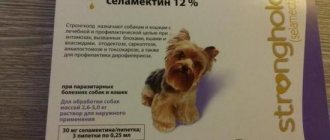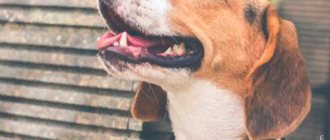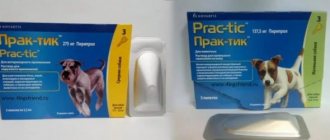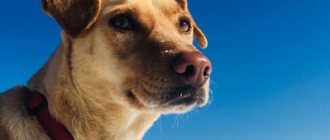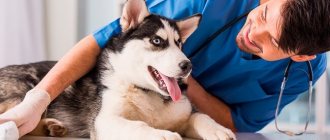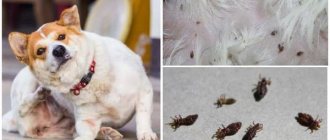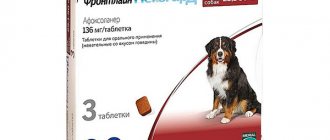Fans of four-legged friends often face the problem of how to remove fleas from their pets. It is impossible to watch how your beloved animal suffers, scratches its skin to wounds, sleeps poorly and whines. In addition, the presence of parasites can cause an allergic reaction and skin disease. The solution to the problem is flea shampoo for dogs.
Washing a dog with flea shampoo.
pros
Despite their effectiveness, shampoos are low-hazard substances that do not cause severe irritation when they come into contact with mucous membranes, and you can also combine treatment with hygienic washing. Many of them have additives that improve the structure of the coat.
As a rule, shampoos have a more affordable price than other products. There are series for puppies from an early age, as well as for dogs with different coat types.
How to wash?
The first step is to thoroughly wet the dog's entire coat, including the head, ears and muzzle area.
The shampoo is diluted in warm water and evenly applied to the surface, foaming intensively. Next, following the instructions, you need to wait from 2 to 7 minutes and rinse everything off well with running water. After this, the pet is combed and completely dried.
Pets are prohibited from drinking water in which they bathe.
Is it often necessary?
Shampoo is used once, reused only for entomological reasons.
Suspected fleas in a dog
The first sign of the presence of parasites is the restless behavior of your four-legged friend. In an instant, the previously calm dog jumps up and begins to violently gnaw the insect out of its fur. And no wonder, because flea bites are painful. In addition, bloodsuckers cause harm to your pet’s health:
- redness and itching of the skin due to an allergic reaction;
- hair loss;
- anemia in puppies;
- infection with infectious and viral diseases.
At the first suspicion of fleas, you should carefully examine your pet: flea bites are small wounds that stand out on the skin. If you run a fine-toothed comb through a dog’s fur, you will find white grains between the teeth—insect eggs. Having noticed traces of the presence of bloodsuckers, you should immediately begin rescuing your pet.
Good and inexpensive
The most common shampoos with proven effectiveness:
Celandine
Insecticidal shampoo with active ingredient – permethrin – 0.4%. Many components to protect and nourish the coat. Packaged in 180 ml. The shelf life is 3 years from the date of issue. The action is aimed at fleas, lice, lice.
- + Low toxic. Effective in one go. Has a pleasant smell.
- – Prohibited for use on pregnant and weakened dogs, as well as puppies under 8 weeks of age.
Lugovoy
Just like the previous shampoo, the action is based on permethrin. Available for dogs in three forms: “For dogs and cats” with chamomile, coltsfoot and calendula, “For dogs with short hair” with plantain, thyme, dandelion, lanolin and “For dogs with long hair” with St. John’s wort, sage and burdock root.
- + Low cost. Rarely causes an allergic reaction. Can be selected depending on the type of wool. Gives long-lasting protection.
- – Suitable for puppies from 3 months only.
Leopard
Refers to repellent shampoos. The active ingredients used are essential oils of lavender, costus, clove and pelargonium extract. It also has cleaning properties. The shelf life is 18 months from the date of production.
- + Can be used on puppies from an early age. Low cost.
- – Quite a pungent odor, ineffective in case of severe infestation.
Dana
The active ingredient is permethrin. But unlike “Clandestine” and “Lugovoi”, the effect extends not only to fleas, lice and lice, but also to ticks.
Intended for single use. It has 12 variations of drug packaging - from 50 to 400 ml. The shelf life from the date of production is 2 years.
- + Wide spectrum of action. Has long-lasting protection. According to reviews, it is one of the most effective shampoos.
- – Prohibited for puppies under 12 weeks and for pregnant dogs. It is necessary to keep it on the wool for a long time - from 5 to 7 minutes.
4 with a tail
Shampoo with repellent effect, based on natural citronella oil. The oil not only fights fleas and ticks, but also has a positive effect on the quality of the coat, smoothing it and making it shiny.
- + Allowed for young puppies. Has a pleasant aroma.
- – Better suited for prevention than for severe infestation.
Degtyarny
Tar-based medicinal shampoos for fleas and lice eaters are available from many manufacturers. In addition to their repellent effect, such products have a good effect on the condition of the skin, helping to relieve irritation and eliminate itching.
- + In addition to protecting against fleas, they are effective against various dermatoses. They have a low cost, varying depending on the manufacturer. Allowed for use on young puppies.
- – They have a specific smell. They don't foam very actively.
Bio-Groom Flea&Tick
It is a unique concentrate that provides lasting protection against fleas and lice, and also perfectly conditions the coat. The composition contains coconut oil, which increases the saturation of any colors. It must be diluted in proportions of 1:5.
- + Safe to use on puppies. It has comprehensive care and instant results in improving the quality of wool.
- - High price.
Doctor Zoo
100% natural ingredients: essential oils of thyme, rosemary, red pepper, sage, tea tree, bergamot and chamomile. Foams well and leaves behind a pleasant aroma.
- + Approved for use on puppies from the age of 2 weeks, as well as on pregnant and weakened dogs. Suitable for all types of wool. Low price.
- – Has no effect on ticks.
What means to use to kill fleas and larvae in the external environment?
It is immediately necessary to emphasize one important circumstance: if adult parasites and their larvae in the external environment are not first destroyed, the fight against them will turn into a rather useless undertaking. In addition, in advanced cases, it may turn out that fleas, deprived of the opportunity to attack a protected dog, will begin to intensively “gnaw” the owner of the animal, as well as members of his family
All other fleas (including larvae) live somewhere in the house itself. They love damp and shaded places, ideal for cracks and potholes in flooring, walls, etc. There have been cases when entire “deposits” of flea larvae were discovered under the linoleum in old houses.
The larvae feed on a variety of organic matter, which includes microscopic flakes of skin, feces, and other “goodies.” The less often wet cleaning is carried out in rooms, the more fleas will eventually be in the room.
Using Vinegar
A very simple and cheap product with impressive effectiveness. Of course, you should only use table vinegar of 9% concentration. It is mixed with boiled water in a 1:1 ratio.
Fill any household spray bottle with the resulting mixture and carefully “pouring” it over all the cracks, potholes, and other suspicious places. You will have to do this for three or four days. The treated room is thoroughly ventilated. We note, however, that it will not be possible to completely get rid of the “flavors” of the bite right away.
Tar soap against fleas
Most often, tar soap is used to wash a pet, but it is still wiser to use this product to disinfect the external environment. The fact is that the surface of the skin of dogs is protected by a thin layer of secretion from the skin glands. Soap washes it away too quickly, which leads to undesirable consequences (including dermatitis, dermatoses and eczema).
To destroy fleas and parasite larvae in the external environment, the soap is rubbed on a fine grater and mixed with hot water. Take about ¼ piece per bucket. If the owner does not like the specific smell of tar soap (which, by the way, dissipates rather poorly), then ordinary laundry soap can be used with the same success.
Essential oils
Many essential oils are excellent repellents, and therefore they can and should be used in the fight against fleas. Below we will describe how and what types of them to use for direct treatment of a dog, but for now we will consider the method of “disinfecting” an apartment:
- Oils can simply be dropped into cracks and potholes in both flooring and walls.
- Experienced breeders advise adding them to water for washing floors. It is recommended to add 25 drops of the selected product to one bucket.
- Oils can be mixed with water at the rate of four drops per liter, after which any household spray bottle can be filled with the resulting mixture. It is used to treat the most difficult to reach places in the apartment.
Popular articles What breed of dog does Ellie Dee have?
In both cases, the products are extremely effective, allowing you to completely clear the room of adult parasites and larvae in a few weeks.
Side effects
Specialized flea shampoos are low-hazard substances and even if they come into contact with mucous membranes, they do not cause significant irritation. The active substance remains only on the surface of the coat and does not penetrate the systemic bloodstream. Shampoo overdoses do not occur.
However, cases of individual intolerance to the components cannot be excluded. Outwardly, it will look like dry and irritated skin with redness. The dog may begin to itch, show anxiety, and possibly watery eyes.
In this case, you need to urgently rinse the shampoo off the surface of the coat with water and, if necessary, give your pet an antihistamine. It is worth noting that cases of intolerance are extremely rare.
Effect of shampoo
There are many means to combat fleas in dogs - drops, sprays, collars, but it is shampoos that are most in demand among pet owners.
Shampoos against fleas are preventive and therapeutic; for decorative dogs and puppies, sometimes even preventive agents can be used to get rid of parasites.
When applied, the foam slows down the movement of insects, softens the protective layer of the larvae, which allows insecticides to penetrate inside the parasite. Shampoos are considered the safest means against fleas; in addition, many products contain components that improve the condition and appearance of the coat and simplify the combing process for long-haired pets.
Reviews
Owners
“Children often bring picked up kittens or puppies from the street. And we always try to place them in families. In homeless animals, the issue of fleas is especially acute; sometimes puppies are simply swarming with them. Therefore, what we immediately do is bathe it with flea shampoo.
The effect is noticeable after the first use. I really like the variety of options, including series specifically for young children.”
Olga Novikova, owner of a mongrel dog.
“I am the owner of a Dalmatian dog. In the summer, we constantly go with the whole family to the dacha and our pet Chris always accompanies us. One of his favorite activities is lying on the grass. That's where he most likely picked up the fleas. Since he sleeps in the house both on the bed and on chairs, the absence of fleas is extremely important for us.
We decided to wash him with Lugovoi flea shampoo. I was very worried that it wouldn’t work right away, but no! On the same day, the itching stopped and the fleas were forgotten until the end of the season.”
Ekaterina Zubova, owner of the Dalmatian breed.
Veterinarians
“Flea shampoo is an essential product in the home of any dog owner. It is the most gentle and can be used as first aid when detecting fleas. If the dog is washed frequently, other anti-flea agents will be washed off and thus the protection period will be shortened.
In the case of using shampoos, it is possible to combine two actions into one - tidying the coat and preventing fleas. Most of them are made with herbs and have a pleasant smell of meadow grass. The deodorizing effect lasts for a long time.”
Marina Rudakova, veterinarian.
Important instructions for use
Before using the shampoo, it is necessary to study the attached instructions, which indicate for which animals (puppies or adult dogs) it is indicated, the necessary dosages for using the medicinal product, so as not to provoke poisoning.
Before washing, your pet should be thoroughly combed using a fine-tooth comb. You need to make sure that there are no clumps of fur left, as insects can accumulate in them, and then shampooing will simply be pointless.
The dose of the product indicated in the application must be diluted in the appropriate amount of water and shaken into foam. Distribute it throughout the dog’s fur and leave for a few minutes (the exposure time is also indicated in the instructions), and then rinse thoroughly.
Applying shampoo to a dog.
When washing your dog, you need to be careful to ensure that soap suds do not get into the ears, eyes and mouth. This may cause poisoning.
After washing your pet, you need to pay attention to the area of the face, ears, and chin, where fleas could be located, and remove them. And then carefully comb the animal again with a comb to remove all dead or damaged insects.
After the first use of shampoo, you need to monitor your pet for 24 hours in case an allergic reaction occurs. If dry and irritated skin is detected, the dog should be given antihistamines.
If the animal is lethargic, does not eat well, or has increased salivation, these may be signs of poisoning with a potent substance or an overdose. In this case, you need to give your pet milk, then show it to the veterinarian.
How often can you wash your dog with a special shampoo?
The frequency of washing depends on the specific action of the selected shampoo.
When using insecticidal agents, the period of protective action lasts from 14 to 20 days, so you should not wash your dog with a special preparation more often than the specified period, otherwise an overdose may occur.
The protection period of natural shampoos is much shorter and averages a week, so you can wash your animal once every seven days if necessary.
